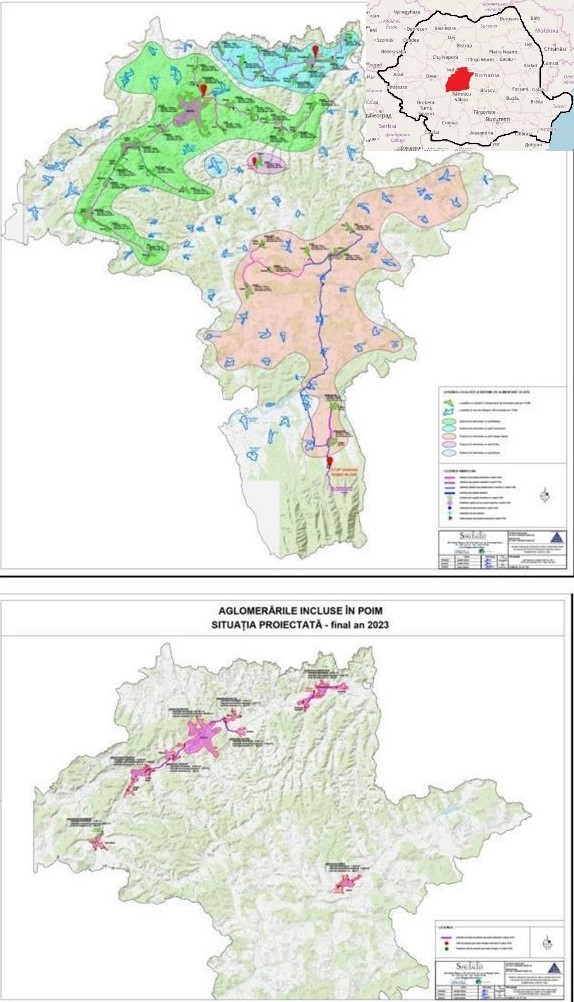An EU-funded project is improving and extending water and wastewater infrastructure in urban areas of – and rural areas around Agnita, Dumbrăveni and Mediaș, in Sibiu County, Romania. The upgrades will enhance the quality and safety of water services and wastewater collection and treatment, helping to bring them into line with EU and national legislation and reduce water losses.
Improvements to water and wastewater infrastructure in Sibiu County, Romania
- 27 October 2022
Work on water supply covers the supply systems of Arpaşu-Agnita, Dumbrăveni, Mediaș and Richiș; that on wastewater covers the areas of Agnita, Dumbrăveni and Șeica Mare, and a cluster of settlements around Mediaș: Brateiu, Copșa Mică, Dârlos, Târnava and Mediaș itself.
Extensive upgrades
Water supply upgrades include rehabilitation of 28.424 km of main pipeline and 101.182 km of water distribution network and laying of 142.994 km of new main pipes and 73.746 km of distribution network.
A water pumping station will be rehabilitated, and 26 new pumping stations, 25 new drinking water storage tanks and 25 new chlorination stations will be built. One water source will be extended, with the drilling of four wells, and another will be rehabilitated. A micro-hydropower plant will be developed for energy recovery, and electricity supply infrastructure will be improved.
As regards wastewater, 55.063 km of sewerage network will be laid, of which 20.398 km will be overflow pipe, and 74.714 km of sewerage network will be rehabilitated, of which 6.96 km will be overflow pipe.
A sludge drying plant, three sewage reception units – in Agnita, Dumbrăveni and Mediaș – and 34 sewage pumping stations will be built, and eight wastewater pumping stations and a wastewater treatment plant in Șeica Mare will be rehabilitated.
For both water supply and sewerage systems, the supervisory control and data acquisition (SCADA) system will be extended to monitor the functioning of the infrastructure and factors such as accidental pollution and drinking water quality.
Operating equipment to be acquired includes a truck for work on water distribution networks, two drinking water analysis laboratories and a fire engine.
Remedying deficiencies
The main water supply deficiencies in the area include incomplete coverage of supply and SCADA systems, localities without supply or with water quality or quantity problems and operational issues at treatment plants. Furthermore, the capacity of distribution networks and storage reservoirs is insufficient and infrastructure is damaged, resulting in water losses, service disruption and health risks.
Problems with the wastewater systems include insufficient coverage, even in urban areas; insufficient network capacity; blockages in and leaks from sewerage pipes, causing health and environmental risks; and insufficient drying and difficulties with disposal of sludge.
Thanks to the improvements, connection rates in the area to water supply networks and to supplies of drinking water that meets European and national quality standards will rise from 74.46 % and 61.04 % respectively to 98.49 %. Water losses will be reduced from 1.64 million m³ to 0.75 million m³.
Connection rates to sewerage networks will increase from 76.5 % to 98.3 %, and the percentage of wastewater collected and treated in accordance with EU legislation will increase from 69.1 % to 98.3 %.
The project is divided into two phases: phase I will begin in the 2014-2020 programming period, to be followed by phase II in the 2021-2027 programming period. The project as a whole is expected to be finalised in 2026.
Total investment and EU funding
Total investment for the project “Regional Project for Development of water and waste water infrastructure in the regions of Medias, Agnita and Dumbraveni, Sibiu County” is EUR 200 464 170, with the EU’s Cohesion Fund contributing EUR 65 208 308 for phase I through the “Large Infrastructure” Operational Programme for the 2014-2020 programming period. The investment falls under the priority “Development of environmental infrastructure under conditions of efficient resource management” .

